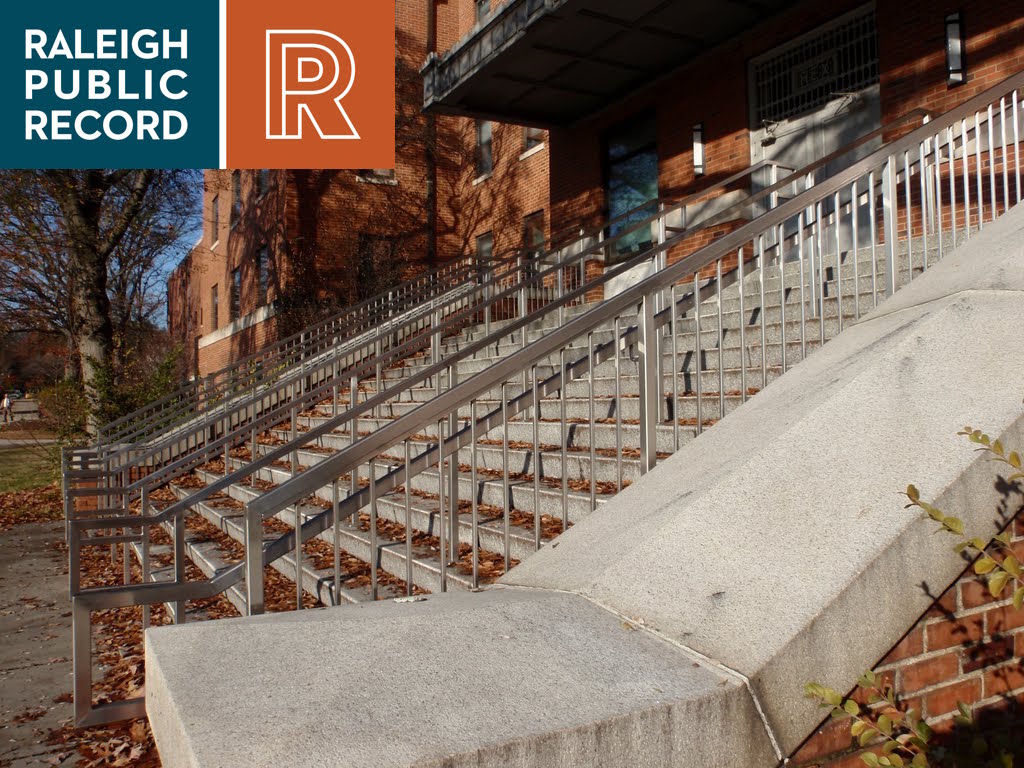Brought to you by Rufty-Peedin Design Build
Thursday, July 7, 2016
It’s easy to miss.
Set on a hilltop overlooking the intersection of Wade and St. Mary’s but mostly concealed behind a thick cover of trees, the sprawling 15-acre campus that’s home — at least for now — to the State Division of Employment Security, can trace its roots back to 1937, when it became the third site for Raleigh’s ever-expanding Rex Hospital.
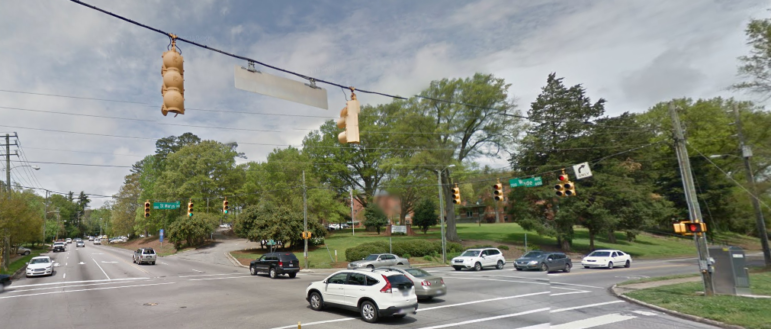
Google Maps
Old Rex lies behind those trees to the right
Rex Hospital’s first location opened in May 1894 in downtown Raleigh near the intersection of South and Salisbury. It operated out of the former home of one-time Governor Charles Manly, not far from where the present-day Duke Energy Center is located.
Less than 15 years later, the hospital had outgrown the Manly Mansion despite several expansions, and relocated to a different site on South Street a few blocks to the east, a location that lasted a few years longer than the original.
In November 1935, the cornerstone was laid for the newest incarnation of the hospital, this one at the intersection of Wade and St. Mary’s. The existing parcel had previously been owned by a number of different entities, including the nearby Methodist Orphanage, all of which sold their land to Rex.
History doesn’t repeat itself but it often rhymes, so it was no surprise that after 40 years at the St. Mary’s site, the Rex Trustees began seeking out a newer, larger home. On September 21, 1980, the fourth and to-date final location of Rex Hospital was opened at 4420 Lake Boone Trail in West Raleigh.
The State of North Carolina finalized the purchase of the Old Rex site in 1981 for a listed price of $2.45 million.
But that’s all in the past. The big question is: what does the future hold for this prime piece of ITB real estate?
The truth is, no one really knows, save for this: it’ll soon be sold to the highest bidder.
Project Phoenix
In a presentation to the Urban Land Institute in March of this year, the Old Rex site was one of about a dozen properties mentioned in the context of the State’s ongoing Project Phoenix.
Project Phoenix is an effort by the State government to revitalize or sell off currently owned State property. A press release issued at the time of Phoenix’ debut boasted that “State government will become points of pride in our communities, not blemishes.”
In the March presentation, it was stated that the Old Rex site was “ripe” for multiuse development, and that the State planned to lease it “as is” using a third-party broker.
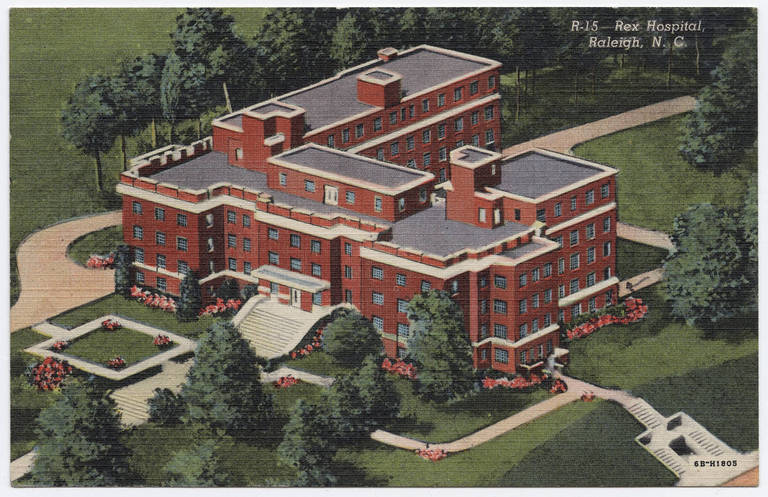
UNC Wilson Library
A drawing of the original Rex Hospital at Wade and St. Mary’s
“The State was initially going to lease the property for 99 years, but decided to sell the property instead,” explained Christopher Mears, a Public Information Officer with the NC Department of Administration in an interview with The Record earlier this week.
In October 2015, the State issued a Request for Proposals in order to find a real estate broker to market and lease out the property. International real estate firm Jones Lang Lasalle was awarded the contract and will be paid a 2.5 percent broker’s fee for these services. We had previously listed the contract at $300,000, a figure provided by the State Purchasing Office. Mears clarified that JLL would be paid a percentage-based fee rather than a flat amount.
Bill Sandridge, a managing director at JLL assigned to the Old Rex property, told The Record his firm was still conducting due diligence on the site, a process with no set end date.
“We’re trying to find out everything we can about the site,” Sandridge said.
Among the 11 requirements for the brokerage firm listed in the State’s RFP was one necessitating that JLL “Conduct comprehensive research of the condition of the property and existing buildings and structures on the site from historical records, including potential environmental issues, zoning, transportation corridor plans and access, easements, past and proposed plans and studies by the City of Raleigh, etc.”
Given the size and scope of the Old Rex property, it makes sense JLL can’t give a hard end date for completing such a litany of requirements.
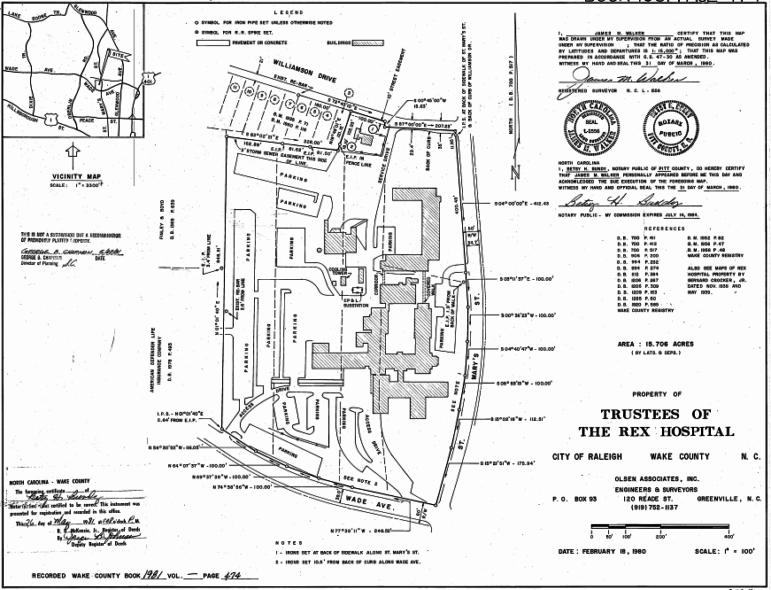
A survey of the site conducted prior to its sale to the state in 1980
Sandridge said it was too early at this point to speculate on what kind of development might be coming to the site, and Mears said “the market will determine” what happens next.
The genesis of today’s column was a rumor that Old Rex would be developed into an affordable housing project, but Mears said such a move would require a buyer willing to pay top dollar for a high-value property only to turn around and use it for affordable housing.
In addition to losing money on the project, the developer would likely face an intense battle with the surrounding neighborhoods over such a plan.
The property is currently zoned OX-5, or Office Mixed Use with a height limit of five stories. Residential, office and limited retail development are all allowed within such a zoning classification. As these kind of high-end developments have been cropping up all throughout the city, it wouldn’t be much of a surprise if a new development just gets built out under the current zoning.
Insight Into the Future
It’s of course possible the property’s future owner could seek to rezone the land to allow for higher-intensity development.
Our friend Adam Zaytoun over at Rufty-Peedin Design Build, however, whom we asked to weigh in on the future of the site, pointed out that in addition to the zoning, the property is also designated for office and residential development on the City’s Future Land Use Map.
One of the most important aspects in any rezoning case is its consistency with that FLUM, so an increase in intensity from OX would likely be at odds with the designation from that map.
Zaytoun, whose firm is currently working on an adaptive reuse project over on Hillsborough Street for the H-Street Kitchen, said he imagines whoever buys the Old Rex property would choose to tear down and build new instead of transforming the old hospital into a series of apartments, offices and small retailers.
“Unless there’s a state tax incentive to keep [the existing buildings], it wouldn’t make sense for anybody to try and preserve them,” Zaytoun said.
“Obviously, I’d love to see them preserved; but at the end of the day it’ll be up to whoever ends up purchasing the land.”
Although he has a personal connection to the place — his 95-year-old grandmother volunteered with Rex for 51 years, and still remembers the day the hospital moved to Lake Boone Trail — Zaytoun isn’t sure a future developer will be able to make much use out of the buildings added to the campus in the 1950s and 1970s.
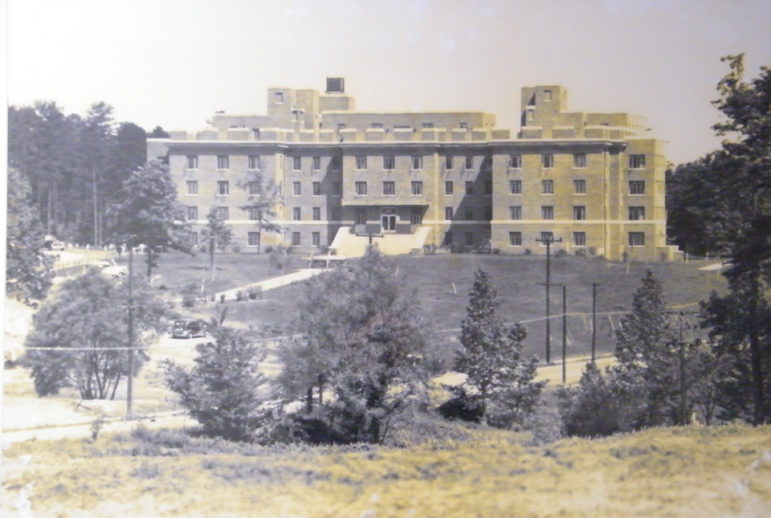
Rex Hospital
An early photograph of the Wade/St. Mary’s site
“I don’t see how you could repurpose them,” he said of the accessory structures.
Ideally, Zaytoun said he’d like to see a five-story office and residential mixed-use development on the site with a mix of affordable housing.
“It’s 15 acres, it could be four or five different buildings on the site,” he added.
The site presents a number of built-in advantages for any developer, Zaytoun said. One is the large amount of impervious surface already on the property, which would allow the placement of a parking deck on top of an existing surface lot. As this would not increase the total amount of impervious surface, the developer may not be required to install, for instance, a water-retention pond.
Technical details aside, Zaytoun said the best thing about the site is its prime, hilltop location.
“366 feet is the highest point there; that’s higher than downtown,” Zaytoun said.
The elevation level of downtown Raleigh is about 315 feet.
“Whatever’s perched up there is going to have an eagle-eyed view, you’ll be able to see downtown pretty clearly, you’ll be able to see Broughton High.”
“It’s a great location.”
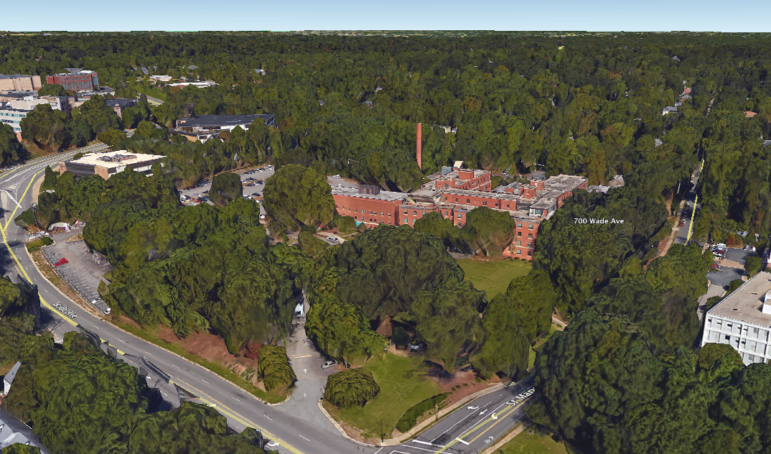
Google Earth
A Google Earth overview of the site
Fast Facts About Old Rex
We were blessed with a surplus of material today, but that meant we couldn’t squeeze in all the technical details we normally would, so we’ll lay them out in bullet points instead.
- Originally built in 1935, completed in 1937, opened May 30, 1937
- Property & Buildings currently have an assessed value of $29,560,987
- Purchased from Rex by the State of North Carolina in 1981 for $2.45 million
- Designed in the Art Deco style by H. Colvin Linthicum, one the first architects in North Carolina to gain his license after passage of the licensing act in 1915. H.C. Linthicum’s certificate was #23
- John Rex, whose will established the Rex Hospital Trust, was a “wealthy landowner, tanner and moneylender” who was described as a “grave, quiet, retiring, modest man.”
- In 1861, the funds in that trust had grown to more than $40,000, which trustees used to purchase Confederate bonds. At the end of the Civil War, the fund was worth less than $1,000. Whoops.
- Wade & St. Mary’s Rex location originally had 174 beds
- When the hospital relocated from Wade to Lake Boone Trail, the patients were transferred in a single day using the help of “the National Guard, 15 area Emergency Medical Services ambulances, and all the Wake County School System’s wheelchair buses.”
- Campus is made up of five separate buildings and seven different wings:
- 1937 “Central” building containing wings A, B and C is five stories tall, has a total gross square footage of 123,933, was acquired for $624,622 and is currently valued at $16,692,335
- 1952 “Laundry/Boiler” building contains wing J, is two stories tall, has a gross square footage of 10,420, was acquired for $16,477 and is currently valued at $300,000
- 1957 building known only as “Wing D” is four stories tall, has a gross square footage of 28,448 was acquired for $122,177 and is currently valued at $0, at least according to State records
- 1957 “Cafeteria” building containing Wing E is two stories tall, has a gross square footage of 11,808, was acquired for $37,776 and like Wing D is currently valued at $0 per State records
- 1970 “Job Service Office” building containing Wing is stories tall, has a gross square footage of 15,525, was acquired for $108,675, and, like the other two before it, allegedly valued at $0.
- Cover photo for this article comes care of Tom Pope, who photographed the staircase at Old Rex way back in 2001
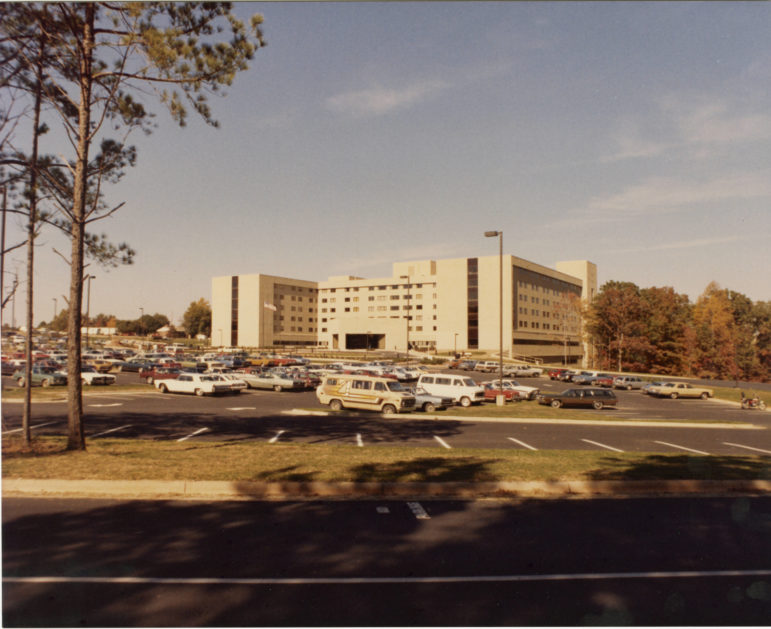
Rex Hospital
The Lake Boone Hospital in the 1980s
